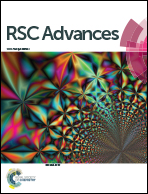Bioinspired fabrication and lead adsorption property of nano-hydroxyapatite/chitosan porous materials†
Abstract
Both hydroxyapatite (HAP) and chitosan (CS) powders have good adsorption activity for Pb2+ ions, but it is difficult to separate the adsorbent powders from wastewaters. Herein, we report the bioinspired fabrication of nano-HAP/CS porous materials (HCPMs) according to the following steps: (i) freeze-drying fabrication of brushite (DCPD)/CS porous materials (BCPMs); and (ii) conversion of HCPMs from BCPMs by alkaline solution treatment. The HCPMs possess interconnected three-dimensional (3D) macropores with a pore size of 150–240 μm and a porosity of 93.0%. The nano-HAP rods with a length of ∼500 nm and a diameter of ∼20 nm disperse uniformly within the porous materials. As lead aqueous solutions flow through the HCPMs, the Pb2+ ions are chemically adsorbed on the adsorbents by forming lead hydroxyapatite (PbHAP, Pb10(PO4)6(OH)2) and CS–Pb complex. The conversion mechanism of HAP to PbHAP is a dissolution–precipitation reaction. Notably, the pH values of lead solutions have a great effect on the adsorption capacity of the HCPMs. On decreasing the pH values from 7.0 to 2.5, the experimental equilibrium adsorption amount increases from 208.0 to 548.9 mg g−1. Adsorption kinetics and adsorption isotherm studies reveal that the adsorption of Pb2+ ions on the HCPMs exhibits good compliance with pseudo-second-order kinetic and Langmuir isotherm models. Hence, the HCPMs can be used for the chemical adsorption of Pb2+ ions from wastewater.


 Please wait while we load your content...
Please wait while we load your content...